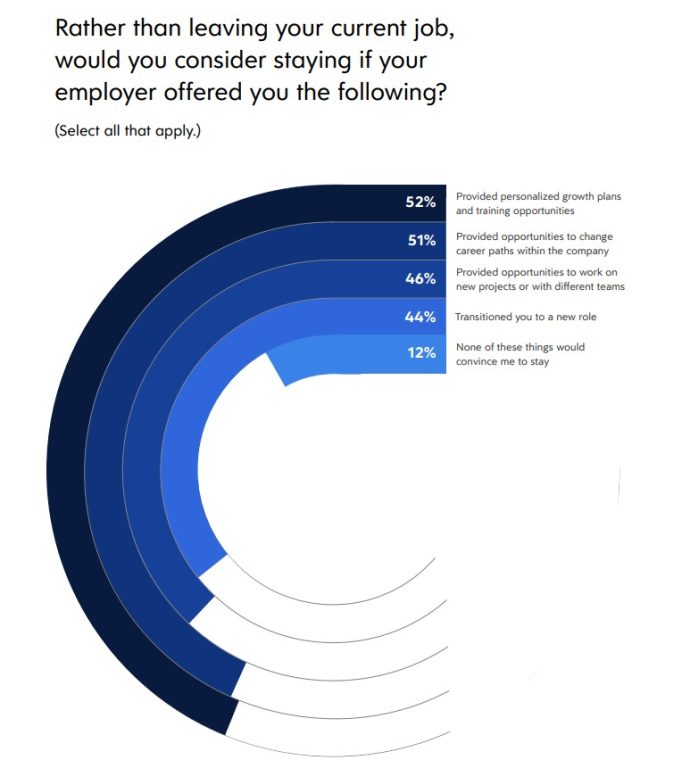Flexible careers help resolve ‘Great Resignation’
Not everyone wants to climb the career ladder, many want lateral opportunities instead.
Why You Should Care
A lack of internal mobility is a leading cause of the war for talent.
The issue is that employers aren't offering the right development opportunities, according to global research by Ceridian.
It's time to move beyond vertical and towards lateral career growth.
Organizations are grappling with a plethora of workplace challenges.
The primary one is record-high attrition rates, dubbed the ‘Great Resignation’; this is compounding another challenge, skills gaps and ensuring employees are resilient and ready for future disruption.
To add to this, the world is facing economic downturns (in fact, the UK is already in a recession). But, rather than encouraging employees to stay put at their current employer, they are still quitting in droves and looking for new opportunities outside of their organization.
A desire for flexibility has been a major driver of the ‘Great Resignation’ over the past 18 months. This has been confirmed by HR tech giant Ceridian’s 2023 Pulse of Talent study.
70% of the almost 9,000 employees from six countries that Ceridian surveyed were a flight risk, 49% were option to new opportunities and 21% were actively looking for new jobs.
32% of those looking for a new job wanted more flexibility, and 49% of all respondents said flexibility and work-life balance were the most important attribute in a job.
But Ceridian’s study found that employees don’t just want a flexible working model, they also want more flexible careers.
Think beyond career ladders
The issue is that “the traditional career path is a ladder, but today, not everyone wants to climb it. For employees today, up isn’t the only direction to go”, according to Ceridian.
Only 17% of the almost 9,000 respondents said they aspire to senior leadership, and just 14% want to be people managers.
Instead, what employees want is more opportunities for lateral career moves; they want opportunities to work on different projects outside their teams, as well as the ability to move into new roles outside of their current team or department.

Credit: Ceridian’s 2023 Pulse of Talent report.
However, 45% said their employer doesn’t understand their career aspiration needs.
Although 27% said internal mobility was crucial to their career aspirations, and 43% wanted to move to a new role in a different department or team, almost half said they struggled to find open roles that might suit them in other teams.
Managers and technology are key
As a result, Ceridian’s report calls on employers to rethink their approach to career development. Ceridian MD for EMEA Wendy Muirhead tells UNLEASH: “Workers today are looking at flexibility from multiple perspectives. It’s time for employers to take advantage of that opportunity and those expectations with a more flexible approach to career pathing.”
But what actions must organizations take?
First of all, they need to offer personalized career paths that align with employees’ aspirations and goals.
To do this, according to Muirhead, employers need to give “employees control over their own career plans, supported by managers and the organization”, doing this “increases employee engagement and retention and improves organizational performance as a whole.”
On the topic of managers, Ceridian’s report is clear that managers play a key role in successful career mobility.
The reported stated: “Middle managers are the foundation upon which career flexibility is built. But people managers can’t support their team members if they don’t feel supported themselves.
“Organizations should consider what they can do to ensure the strength of this foundation”.

Credit: Ceridian’s 2023 Pulse of Talent report.
Another piece of the puzzle is technology to “help employees identify open roles internally that are relevant to their skills and interests”.
It is essential that open roles don’t “default to hiring external candidates for open roles when a suitable candidate could well be available internally. To support this, it’s a good idea to set internal hiring goals, then use data-driven insights to help match the right people with the right roles”, notes Muirhead.
Of course, switching your organization from vertical to lateral career development “won’t happen overnight, but the results easily justify the investment of time and planning.
“Organizations which succeed here have a tremendous opportunity to retain employees, fill skills gaps, build resilience, and be ready for what the future brings”, concludes Muirhead.
If this article caught your interest, you can find more like it here. Enjoy!
Sign up to the UNLEASH Newsletter
Get the Editor’s picks of the week delivered straight to your inbox!

Chief Reporter
Allie is an award-winning business journalist and can be reached at alexandra@unleash.ai.
